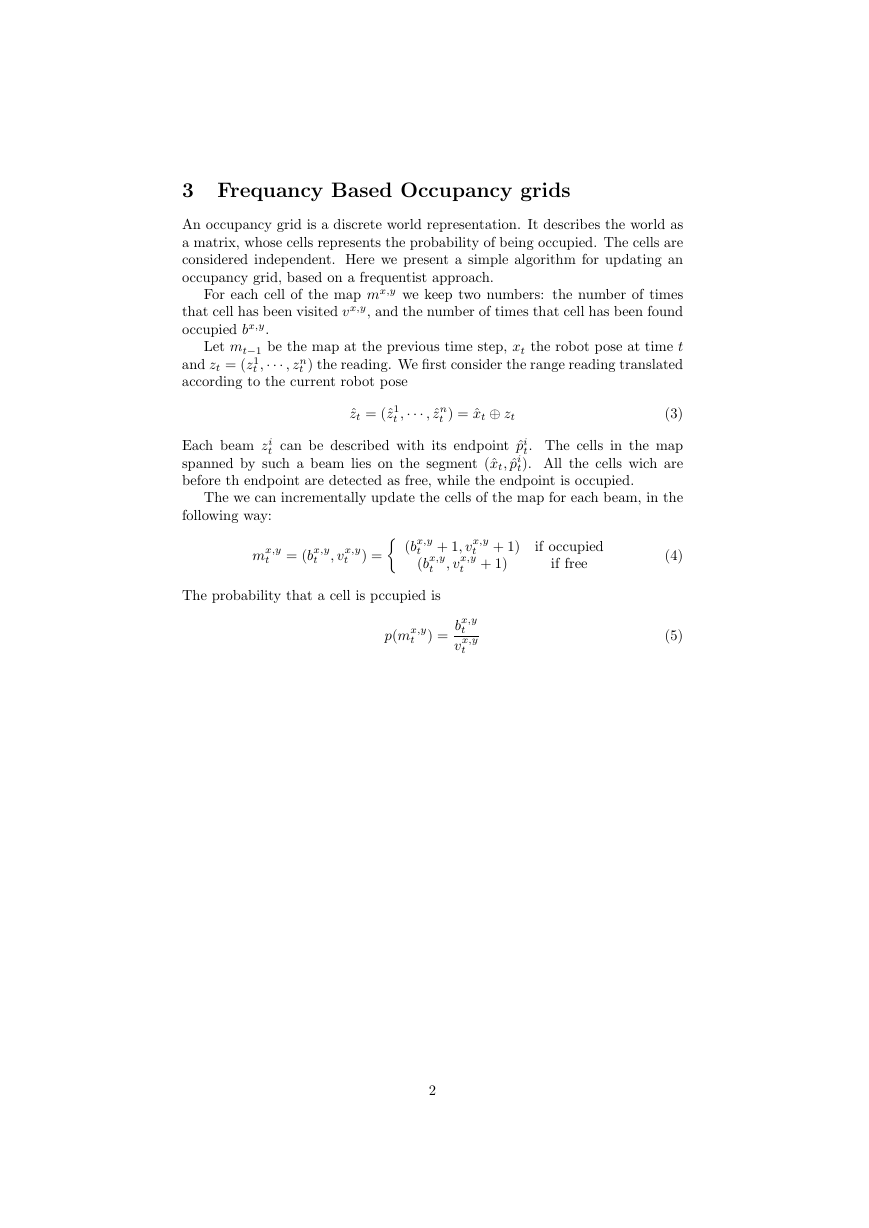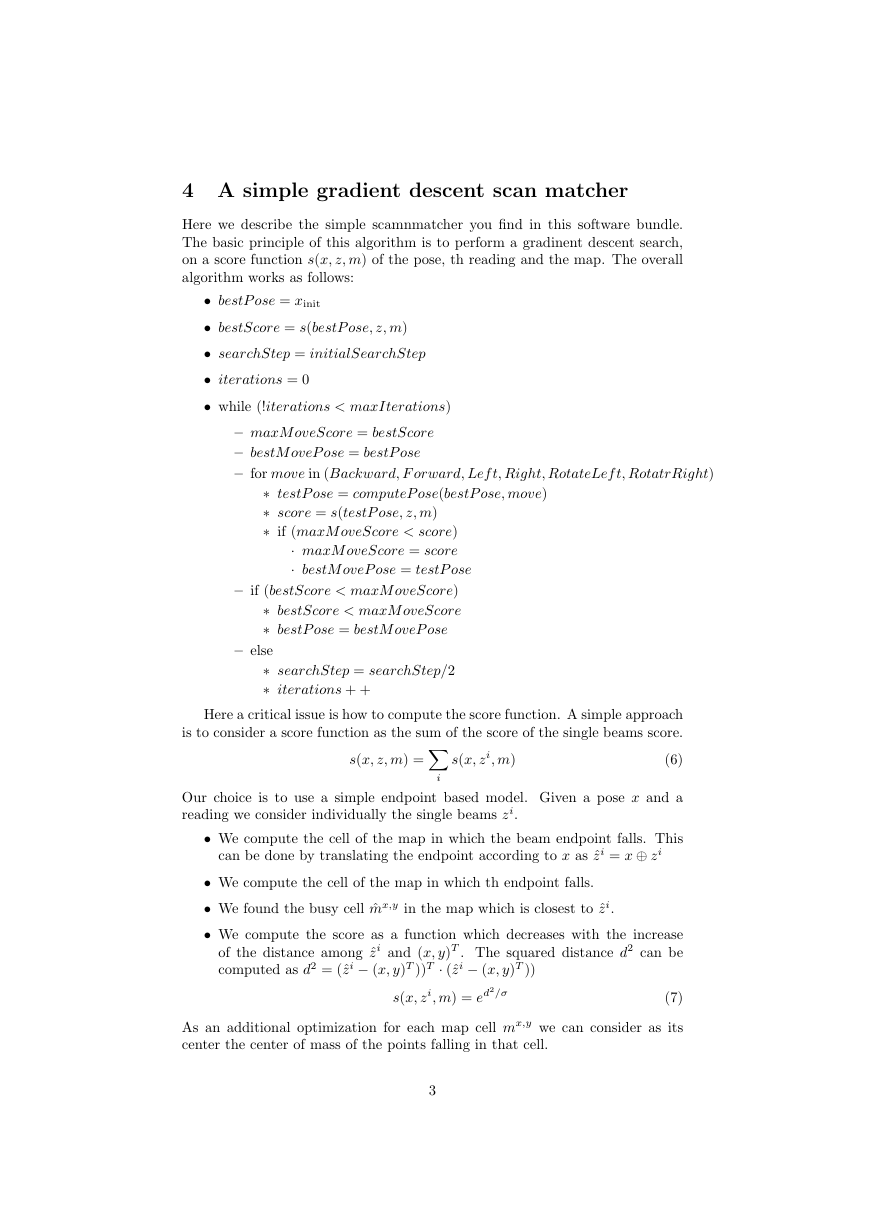An Incomplete Scan Matching Tutorial
Giorgio Grisetti
February 10, 2018
In this document we provide an explanation of the basic concepts for devel-
oping a simple maximum likelihood mapper for laser data. We rst introduce
the notation, then we describe how to compute an occupancy grid map, given
a known set od poses. Subsequantly we present a simple gradient based scan
matchgin algorithm.
1 Notation
xt: robot pose at time t.
|
zt = (z1
{z
}
t ; ; zn
t )
: scan taken at time t.
beams
ut: odometry movement which brings the robot from xt1 to xt, t.
mt = ft(x; y) ! [0; 1] occupancy grid map which can be seen as a function
that maps each point in the probability of being occupied.
2 The Scan Matching Problem
A scan matching algorithm works in two steps:
it determines the most likely pose, given the actual measurements and the
previously build best map:
^xt = argmax
xt
(p(xtjzt; ^xt1; mt1; ut))
(1)
it computes the next step map given the previously built one, the corrected
pose and the range reading:
p(mtjmt1; ^xt; ^zt)
(2)
In the following we present two simple approaches for performing these two
steps.
1
�
3 Frequancy Based Occupancy grids
An occupancy grid is a discrete world representation. It describes the world as
a matrix, whose cells represents the probability of being occupied. The cells are
considered independent. Here we present a simple algorithm for updating an
occupancy grid, based on a frequentist approach.
For each cell of the map mx;y we keep two numbers: the number of times
that cell has been visited vx;y, and the number of times that cell has been found
occupied bx;y.
Let mt1 be the map at the previous time step, xt the robot pose at time t
t ) the reading. We rst consider the range reading translated
t ; ; zn
and zt = (z1
according to the current robot pose
t ) = ^xt zt
Each beam zi
t can be described with its endpoint ^pi
spanned by such a beam lies on the segment (^xt; ^pi
before th endpoint are detected as free, while the endpoint is occupied.
t ; ; ^zn
t. The cells in the map
t). All the cells wich are
^zt = (^z1
(3)
The we can incrementally update the cells of the map for each beam, in the
if occupied
if free
(4)
(5)
following way:
mx;y
t = (bx;y
t
; vx;y
t
) =
{
(bx;y
t + 1; vx;y
(bx;y
; vx;y
t + 1)
t + 1)
t
The probability that a cell is pccupied is
p(mx;y
t
) =
bx;y
t
vx;y
t
2
�
4 A simple gradient descent scan matcher
Here we describe the simple scamnmatcher you nd in this software bundle.
The basic principle of this algorithm is to perform a gradinent descent search,
on a score function s(x; z; m) of the pose, th reading and the map. The overall
algorithm works as follows:
bestP ose = xinit
bestScore = s(bestP ose; z; m)
searchStep = initialSearchStep
iterations = 0
while (!iterations < maxIterations)
{ maxM oveScore = bestScore
{ bestM oveP ose = bestP ose
{ for move in (Backward; F orward; Lef t; Right; RotateLef t; RotatrRight)
testP ose = computeP ose(bestP ose; move)
score = s(testP ose; z; m)
if (maxM oveScore < score)
maxM oveScore = score
bestM oveP ose = testP ose
{ if (bestScore < maxM oveScore)
bestScore < maxM oveScore
bestP ose = bestM oveP ose
{ else searchStep = searchStep=2
∑
iterations + +
s(x; z; m) =
i
s(x; zi; m)
Here a critical issue is how to compute the score function. A simple approach
is to consider a score function as the sum of the score of the single beams score.
(6)
Our choice is to use a simple endpoint based model. Given a pose x and a
reading we consider individually the single beams zi.
We compute the cell of the map in which the beam endpoint falls. This
can be done by translating the endpoint according to x as ^zi = x zi
We compute the cell of the map in which th endpoint falls.
We found the busy cell ^mx;y in the map which is closest to ^zi.
We compute the score as a function which decreases with the increase
of the distance among ^zi and (x; y)T . The squared distance d2 can be
computed as d2 = (^zi (x; y)T ))T (^zi (x; y)T ))
s(x; zi; m) = ed2=
(7)
As an additional optimization for each map cell mx;y we can consider as its
center the center of mass of the points falling in that cell.
3
�






 2023年江西萍乡中考道德与法治真题及答案.doc
2023年江西萍乡中考道德与法治真题及答案.doc 2012年重庆南川中考生物真题及答案.doc
2012年重庆南川中考生物真题及答案.doc 2013年江西师范大学地理学综合及文艺理论基础考研真题.doc
2013年江西师范大学地理学综合及文艺理论基础考研真题.doc 2020年四川甘孜小升初语文真题及答案I卷.doc
2020年四川甘孜小升初语文真题及答案I卷.doc 2020年注册岩土工程师专业基础考试真题及答案.doc
2020年注册岩土工程师专业基础考试真题及答案.doc 2023-2024学年福建省厦门市九年级上学期数学月考试题及答案.doc
2023-2024学年福建省厦门市九年级上学期数学月考试题及答案.doc 2021-2022学年辽宁省沈阳市大东区九年级上学期语文期末试题及答案.doc
2021-2022学年辽宁省沈阳市大东区九年级上学期语文期末试题及答案.doc 2022-2023学年北京东城区初三第一学期物理期末试卷及答案.doc
2022-2023学年北京东城区初三第一学期物理期末试卷及答案.doc 2018上半年江西教师资格初中地理学科知识与教学能力真题及答案.doc
2018上半年江西教师资格初中地理学科知识与教学能力真题及答案.doc 2012年河北国家公务员申论考试真题及答案-省级.doc
2012年河北国家公务员申论考试真题及答案-省级.doc 2020-2021学年江苏省扬州市江都区邵樊片九年级上学期数学第一次质量检测试题及答案.doc
2020-2021学年江苏省扬州市江都区邵樊片九年级上学期数学第一次质量检测试题及答案.doc 2022下半年黑龙江教师资格证中学综合素质真题及答案.doc
2022下半年黑龙江教师资格证中学综合素质真题及答案.doc